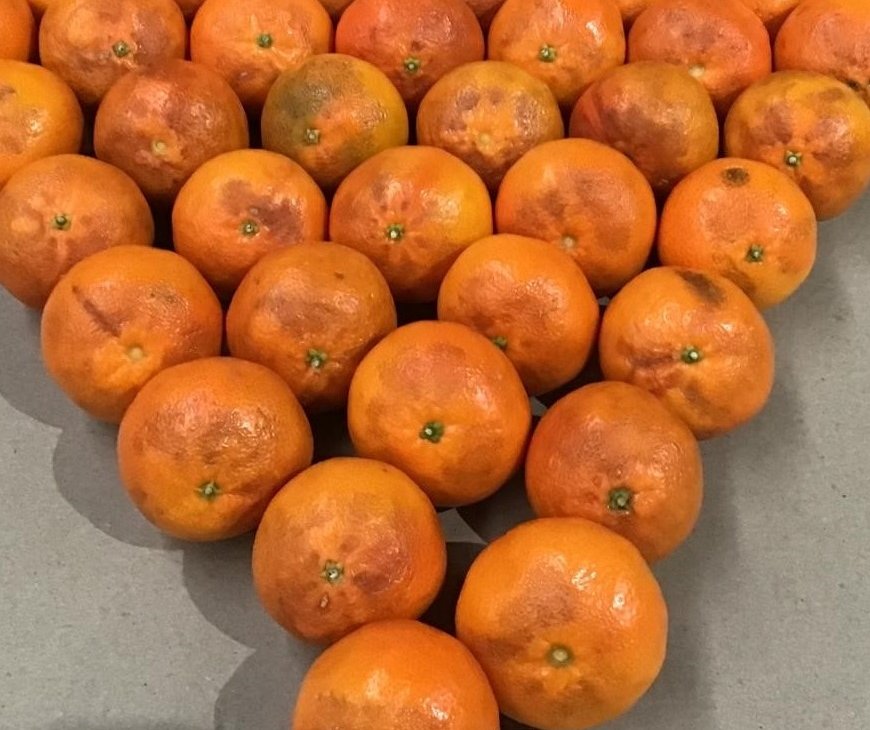By John Golding, NSW DPIRD, and Craig Wooldridge from Muirs
When it comes to citrus, appearance is everything. A bright, smooth peel is often the first thing buyers notice, and anything less can be a dealbreaker. But for growers, maintaining that flawless look isn’t always easy – especially when facing the challenge of stem end breakdown.
Last season, this elusive rind disorder made an unexpected and unwelcome appearance in some late-season oranges and mandarins, causing concern among some citrus producers.
Stem end breakdown manifests as a drying of the peel around the button (calyx), often leaving behind a telltale ring of unaffected skin. This ring, research shows, has a natural advantage – it contains no stomata and is covered in a thick layer of wax, preventing moisture loss and keeping symptoms at bay.
But just beyond that protective barrier, cells begin to dry out, sink in, and sometimes turn brown. This weakened tissue becomes an easy target for decay, making the fruit less marketable.
In Short
In the orchard
• Ensure fruit is not stressed in the orchard before harvest – keep up the irrigation of the orchard, especially during hot dry spells in spring.
At harvest
• Avoid harvesting fruit in hot dry conditions (high temperatures, low humidity and windy), or soon after unseasonal hot dry weather spells.
In the packinghouse
• Process the fruit as soon as possible – ensure postharvest wax is applied as soon as possible.
It’s not new
While stem end breakdown isn’t entirely new, last season’s sporadic occurrences in late Navel oranges and Afourer mandarins raised alarm bells. The problem was particularly noticeable in the southern growing regions, and experts quickly linked it to the extreme heat and dryness experienced in the spring and summer months.
Although some fruit exhibited symptoms at harvest, many cases only became apparent after packing and storage, catching growers and packers off guard. The good news? There are ways to mitigate the risk of stem end breakdown, both in the orchard and beyond.
Prevention starts in the orchard
A healthy rind is the first line of defence against stem end breakdown. Keeping trees well-irrigated, especially during hot dry spells in spring ensures fruit stays hydrated and resilient. Some international research even suggests that applying a gibberellic acid (GA) spray can help slow fruit aging and reduce the risk of rind disorders.
The moment fruit is picked, the clock starts ticking. Harvesting in extreme heat, dry conditions, or immediately after an unseasonal hot spell can exacerbate rind stress, increasing the chances of stem end breakdown.
One effective method to reduce this stress is clip-harvesting rather than snap-picking. Studies show clipped fruit is up to 50 per cent less likely to develop this disorder.
After picking, preventing moisture loss is crucial. Storing fruit in the shade, stacking bins to reduce exposure, and using bin covers can help keep temperatures down and maintain humidity. In warm, dry conditions, it’s also essential to avoid stockpiling fruit – only pick what can be processed within a day to minimise risk.
If short-term storage is necessary, postharvest fungicides should be applied, and the fruit should be kept cool and humid before processing.
Packinghouse best practices
The journey doesn’t end at the orchard. Once in the packinghouse, fruit should be processed as soon as possible. Applying postharvest wax promptly helps lock in the moisture, while rapid cooling further protects against dehydration.
Maintaining low (but non-chilling) temperatures with high humidity throughout storage, transport, and marketing ensures the fruit remains in peak condition.
Another often-overlooked factor? The speed of the packinghouse brushes. Research from Florida suggests that keeping brush speeds below 100 rpm and using automatic wipeouts to prevent fruit from sitting idle on the brushes can significantly reduce water loss and the development of stem end breakdown.
Looking ahead
With the right approach, stem end breakdown can be managed, protecting both fruit quality and marketability.
As climate patterns continue to shift, growers must stay proactive – adapting irrigation strategies, refining harvesting techniques, and optimizing postharvest handling. In a market where visual appeal matters, taking these preventative steps can make all the difference.
By understanding and mitigating stem end breakdown, citrus growers can ensure their fruit meets the highest standards, from the orchard to the consumer’s hand.




